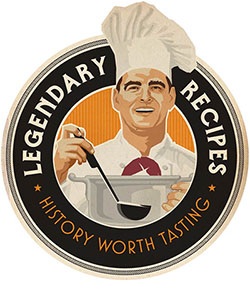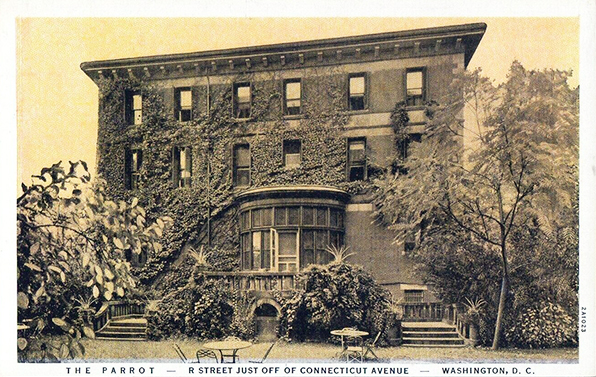In 1926 Jennie Murchison and Ashley Curtis, two sisters from Wilmington, North Carolina, arrived in the nation’s capital with the dream of opening a restaurant that would have all the charm and character of their old Southern home. Neither of them really knew much about cooking, though, aside from what they liked and didn’t like, so their plan was to bring up an African-American cook from back home to run their kitchen.
In short order the Murchison sisters (Ashley had married) leased the former home of Thomas Bell Sweeney at 1643 Connecticut Avenue, N.W., and opened The Parrot Tea Room, using the slogan “Speaks for Itself.” This was the height of the tea-room craze in America, and The Parrot thrived, especially with so many upwardly mobile Washington women being unable to entertain in their small apartments.
A fixture of The Parrot in its early years was “Madame Marie,” who was on hand up to six hours a day to read tea leaves and otherwise divine the future for patrons at “no extra charge.” (Palm readers, psychics, and other seers were so popular in those days that the Washington Post had a special section for clairvoyants “licensed by the District of Columbia” in its classified-ads department.)
In 1932 the sisters moved The Green Parrot to a grand pink-granite and brick mansion at 1701 20th Street, N.W., just a few steps from the intersection of 20th and R Streets above Dupont Circle. The mansion, designed by the noted architects Joseph C. Hornblower and James Rush Marshall and completed in 1891, had originally been the home of George S. Fraser, a New York merchant who had moved to Washington in 1888. Fraser died in 1896, and five years later his widow sold the mansion to Pennsylvania pig-iron magnate Joseph Earlston Thropp, who, after losing his bid to be re-elected to the U.S. House of Representatives in 1900, decided to stay on in Washington. Thropp died in 1927 and his wife in 1930. When the mansion came on the market, the Murchison sisters pounced on it.
The Fraser mansion was grand in every way, beginning with its 32 rooms and 16 fireplaces. With high ceilings, stained-glass windows, crystal chandeliers, rich paneling, and hand-carved details, it looked more like an embassy or privateclub than a restaurant. The sisters used the ground floor for their dining rooms and rented the three floors above to tenants.
In 1934 the Parrot Tea Room became home to the Federal Chess Club, and the following year it began hosting art exhibitions. An early show featured portraits, etchings, drawings, and watercolors by Gene Mercere, a nationally known sketch artist (and former professional boxer) from Indiana who traveled to various cities around the country to draw stage and screen stars, as well as ordinary folk, in pastels.
“Will you have some hot breads right out of the oven?” guests were asked. And there were lots to choose from, including beaten biscuits, freshly baked pocketbook rolls (the southern version of Parker House rolls), cinnamon rolls filled with raisins and currants, and golden-brown corn sticks baked in cast-iron molds.
As for the rest of the menu, the food editor of the Washington Post listed “fried chicken with cream gravy, broiled chicken in butter, imperial deviled crab, lobster à la Newburg, grilled lamb chops, leg of lamb, broiled fish and chicken, spaghetti with mushrooms, and a host of other delectable entrees” in a 1939 review of The Parrot Tea Room.
In 1943 Jefferson L. Ford, Jr., a Washington hotel man, acquired the tea room, renamed it The Parrot Restaurant, and affiliated it in advertising with the Hotel Lafayette, at 16th and Eye Streets, N.W., which he’d owned since 1932. But everyone kept calling it The Parrot Tea Room, Ford didn’t change much in the kitchen, and kept advertising the “famous Parrot fried chickens” and attaching his tag line–“A Jeff Ford Enterprise”—to ads for the restaurant.
Ford operated The Parrot Restaurant until 1950, when he sold it to Johnny and Hilda Goldstein, who renamed it The Golden Parrot. The Parrot Tea Room continued in business until 1950, when it was taken over by Johnnie and Hilda Goldstein, who transformed it into what Paul Herron, the Washington Post’s nightlife reporter, called “a pretty plush establishment that has many features of a swank town house or private club with all the facilities of a modern dining room.” President Dwight D. Eisenhower ate there in 1953 with boxer Rocky Marciano. In 1974, after a long run in the business, the Goldsteins sold the Parrot Restaurant. It soon was transformed into the Golden Booeymonger restaurant, and then nightclubs known as Larry Brown’s and Sagittarius. In 1981 Walter Sommer bought the mansion for $2 million and after a $3 million renovation, opened the luxury The restaurant Fourways. The Church of Scientology acquired the landmark building in 1994, bringing an end its life as a restaurant.

Lemon Chiffon Meringue
Instructions
Heat oven to 250 degrees. Use an electric mixer to beat egg whites. When whites begin to hold stiff peaks, gradually add half the sugar. When peaks become glossy, gently fold in remaining sugar.
Line a baking sheet with parchment paper. Shape the meringue like a tart and bake in a very slow oven for 20 minutes. Meringue is ready when it releases from parchment paper. Turn oven off, prop door open, and allow meringue to sit in oven for an hour or so.
Meanwhile, prepare the filling. Soften the gelatin in a little cold water for about 10 minutes. Beat egg yolks slightly and combine with sugar and gelatin in a double boiler or a metal bowl place over a pot of boiling water. Cook over simmering water, stirring constantly, for about 10 minutes. Add the rind of 2 lemons and the juice of 4 lemons and continue to cook until the mixture is thick enough to coat a metal spoon. Remove from heat and set aside to cool.
Beat egg whites until they hold stiff peaks. Fold the cooled lemon mixture into the beaten egg whites.
Fill the meringue shell and decorate with whipped cream. Refrigerate until ready to serve.










No Comments